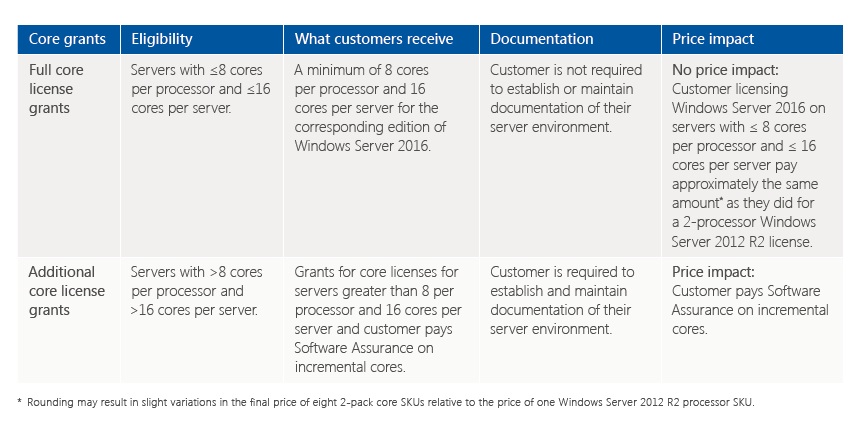Licensing Windows Server 2016
Product overview
Windows Server 2016 is the cloud-ready operating system that supports customer workloads while introducing new technologies that make it easy for customers to transition to cloud computing when they are ready. Windows Server 2016 delivers powerful new layers of security along with Azure-inspired innovation for the applications and infrastructure that power business.
Editions overview
Customers can choose from three primary editions of Windows Server, based on the size of the organization as well as virtualization and datacenter requirements:
• Datacenter Edition is ideal for highly virtualized and softwaredefined datacenter environments.
• Standard Edition is ideal for customers with low density or non-virtualized environments.
• Essentials Edition is a cloud-connected first server, ideal for small businesses with up to 25 users and 50 devices. Essentials is a good option for customers currently using the Foundation Edition, which is not available with Windows Server 2016.
Windows Server 2016 features
Windows Server 2016 customers benefit from a variety of new features. New features in Standard Edition include Nano Server and unlimited Windows Server containers; customers also receive rights to two Operating System Environments (OSEs) or Hyper-V containers. New features exclusive to Datacenter Edition include Shielded Virtual Machines, software-defined networking, Storage Spaces Direct, and Storage Replica; customers receive rights to unlimited OSEs or Hyper-V containers and unlimited Windows Server containers.
Windows Server 2016 licensing model
The business model for Standard and Datacenter editions transitioned from processor-based to core-based licensing in October 2016 with the general availability of Windows Server 2016 (all other editions of Windows Server 2016 continue to be on the processor-based licensing model). Core-based licensing provides a more consistent licensing metric across environments, enabling multicloud environments, improving workload portability for Windows Server through benefits like Azure Hybrid Use Benefit (AHUB), and helping remove friction across different licensing models.
Customers with Software Assurance will transition to core-based licensing at their first renewal after the general availability of Windows Server 2016, although they can deploy Windows Server 2016 at any time.
The Windows Server 2016 licensing model includes both Cores + Client Access Licenses (CALs). Each user and/or device accessing a licensed Windows Server Standard, Datacenter, or Multipoint edition requires a Windows Server CAL or
Windows Server and Remote Desktop Services CAL. A Windows Server CAL gives a user or device the right to access any edition of Windows Server of the same or earlier version. Each Window Server CAL allows access to multiple licenses of Windows Server.
Windows Server 2016 Standard and Datacenter: Core-based licensing
Core-based licensing requires all physical cores in the server to be licensed. Servers are licensed based on the number of processor cores in the physical server.
• A minimum of 8 core licenses is required for each physical processor and a minimum of 16 core licenses is required for each server.
• Core licenses are sold in packs of two.*
• Standard Edition provides rights for up to 2 Operating System Environments or Hyper-V containers when all physical cores in the server are licensed. For each additional 1 or 2 VMs, all the physical cores in the server must be licensed again.
• The price of a set of 16 core licenses (for a 2-processor server) for Windows Server 2016 Datacenter and Standard editions is the same price** as the 2-processor license of the corresponding edition of Windows Server 2012 R2.
Moving to core-based licensing
Customers purchasing net new licenses, for example, through MPSA or from an OEM, will purchase licenses under the core-based model.
Existing customers with Software Assurance will transition from processor-based to core-based licensing at the first renewal after the general availability of Windows Server 2016.
• Renewal before the general availability of Windows Server 2016: Customers with Software Assurance will be on processor-based licensing and true-ups will also be processor-based.
• Renewal after the general availability of Windows Server 2016: Customers with Software Assurance will transition to core-based licensing and true-ups will also be core-based.
Core license grants overview
Customers with servers under Software Assurance will receive core license grants at the expiration of Software Assurance coverage. Depending on the core density of existing servers, there are two categories of core license grants: Full core licenses and additional core licenses.
1. Full core license grants: Customers with a server density of 8 or fewer cores per processor and 16 or fewer cores per server are eligible to receive full core license grants. Customers will receive a minimum of 8 cores per processor and 16 cores per server at the expiration of Software Assurance coverage after the general availability of Windows Server 2016. To receive full core license grants, customers do not need to document their environments.
2. Additional core license grants: Customers with a server density of more than 8 cores per processor and 16 cores per server are eligible to receive additional core license grants and pay only Software Assurance on the incremental cores. To receive additional core license grants, customers must maintain a record of the physical hardware and the configuration of the licensed server by using the Microsoft Software Inventory Logging tool (SIL) or any equivalent software. Inventory must be maintained at the first expiration of the Software Assurance coverage after the general availability of Windows Server 2016 or before September 30, 2019.
Announcing servicing guidelines for Windows Server 2016
With prior releases, Windows Server has been serviced and supported through a 5+5 model, with 5 years of mainstream support and 5 years of extended support. This model—renamed Long Term Servicing Branch (LTSB)—will continue with Windows Server 2016 for customers who choose to install full Windows Server 2016 with Desktop Experience or Server Core.
Customers choosing the Nano Server installation will opt into a more active servicing model—known as Current Branch for Business (CBB)—similar to the experience with Windows 10. This approach supports customers who are moving at a cloud cadence of rapid development lifecycles and wish to innovate more quickly. Since this servicing model continues to provide new features and functionality, Software Assurance is also required to install and use Nano Server.
Kata Kunci Terkait:
Windows Server 2016 licensing model, Windows Server 2016 Core-based licensing, Windows Server 2016 Core license grants, windows server 2016 licensing guide, windows server 2016 licensing changes, windows server 2016 licensing cost, windows server 2016 licensing brief, windows server 2016 licensing vmware, windows server 2016 licensing calculator








